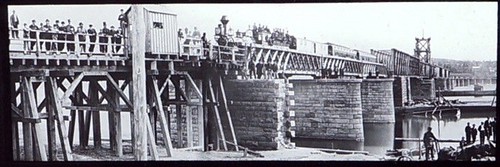The Hudson River Bridge Company built the first structure to cross the Hudson at Albany. When it opened in 1866, it was simply the Hudson River Bridge. Once the Maiden Lane Bridge opened at the end of 1871, the older bridge was often called the North Bridge. Eventually, it picked up the moniker of the Livingston Avenue Bridge, the name by which it is known today.
The President of the company was Dean Richmond, who had in 1864 been chosen to replace the retiring Erastus Corning as president of the New York Central Railroad Company. Secretary and Treasurer was Sidney T. Fairchild, an attorney from Cazenovia who was general counsel for the New York Central, among many other positions. (The son of this secretary/treasurer, Charles S. Fairchild, later became secretary of the United States Treasury.) Other members of the Board of Directors of the bridge company were Erastus Corning and Henry H. Martin, who served Corning in banking and railroading, as well as some other interesting railroading characters. One was William H. Swift, a bartender turned inspector with the railroad; James H. Banker and Augustus Schell filled out the Board. The construction team also served on the Board: Julius W. Adams, bridge engineer; A.F. Smith, Superintendent of Construction; and Charles Newman, Bridge Builder.
The Albany Evening Journal’s Feb. 23, 1866 account of the first crossing of the bridge was captured in the 1866 Annual Report of the Railroad Commissioners of the State of New York:
“Crossing the Bridge. – After the meeting of the Directors of the Hudson River Bridge Company, yesterday afternoon, and shortly after three o’clock, a train consisting of four cars, drawn by the locomotive “Lyman J. Lloyd,” belonging to the Central Railroad Company, started from the depot on Maiden Lane for a trip across the bridge. The Directors of the Bridge Company, several of the Directors of the Central railroad, and a number of the employees of the company, together with officers of the Hudson River, Harlem and Boston railroads, were passengers on the train. The train was drawn back by the locomotive “James H. Banker,” belonging to the Hudson River Railroad Company.
Subsequently a freight train, consisting of eight cars, loaded, belonging to the “Red Line” – through cars from Chicago to New York – passed over the bridge safely.
The Annual Report also recorded this March 5, 1866 article from the Albany Argus, explaining the importance of the new bridge:
Railroad Changes at Albany. – The revolution in railroad travel at this point, produced by the erection of the Hudson river bridge, is a very important one. For years the crossing of the Ferry at Albany has been a great inconvenience to the traveling public. Especially has this been the case during the fall and winter months, when persons leaving the warm cars on either side have been exposed to the cold winds on the river.
All the trains now leave this city from the New York Central Depot, near the Delavan House. On Saturday this new arrangement was in full operation. The Hudson River, the Harlem and the Boston trains all landed their passengers on this side of the river, and all the trains leaving this city for New York or Boston started from the same locality. Passengers going East or West had only to step from one train to another. The trains of the New York Central and the other roads named, all started from the same depot.
Trains are also run from New York to Buffalo and Suspension Bridge without any change whatever. Passengers from either of the points named can retain their seats through the whole route. These trains are called the “Red Line,” the cars being painted red to distinguish them from the other trains. They are elegantly fitted up, and provided with all the comforts and conveniences possible to furnish, for such a long journey.
This new arrangement will involve important changes in connection with travel through this city. The ferry boats will be almost entirely relieved from business, except so far as local traffic is concerned. The crowds of carts, and drays, and passengers, at the foot of Maiden Lane, will be no longer witnessed. The ticket and baggage offices of the Boston railroad will be transferred to the New York Central railroad yard, and from the locality tickets will be sold, and baggage checked for all points leading from the city by railroad, except the Albany and Susquehanna route.
This great revolution has been effected by the construction of the Hudson River bridge, and it must be acknowledged that the change will be very welcome to the traveling public. The result has produced a concentration of the trains on all the roads named at one point, and we presume it will be for the interest of these several corporations to unite in the erection of an immense depot which will afford ample accommodations under this new state of things.


Leave a Reply